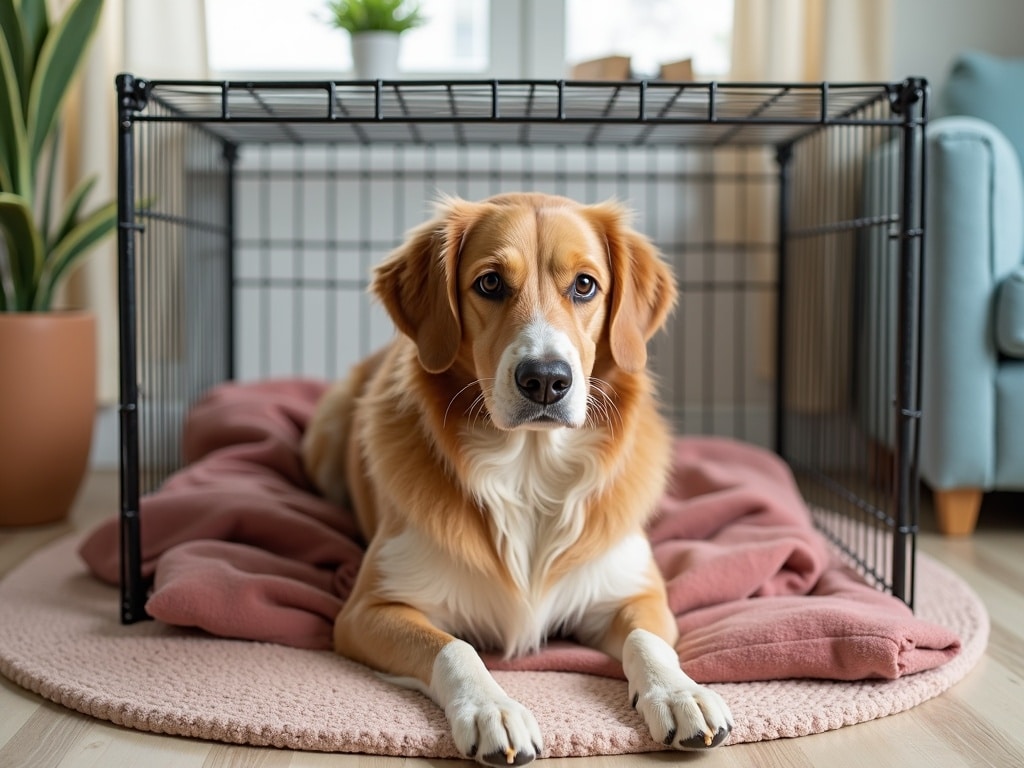How to Make a Dog Crate More Comfortable: Creating a Cozy Den for Your Best Friend
Imagine a sanctuary. A place where you feel safe, relaxed, and utterly at peace. That's what a dog crate should be for your furry companion – not a jail cell, but a cozy den, a personal haven. Many pet owners view dog crates with a certain apprehension, associating them with punishment or confinement. But when introduced and furnished correctly, a crate can become an invaluable tool for training, security, and, most importantly, comfort. Far from being a source of stress, a well-appointed crate can offer your dog a sense of belonging and a retreat from the chaos of daily life. So, how do you transform a wire cage or plastic kennel into a palace of canine contentment? Let's explore the secrets to making a dog crate more comfortable, one plush pillow and soothing scent at a time.
Why Comfort Matters: The Benefits of a Cozy Crate
Before diving into the how-to, let's understand the why. A comfortable crate offers more than just a soft place to nap. It taps into a dog’s natural instinct to seek out den-like spaces, providing a secure and familiar environment. This sense of security can be particularly beneficial for:
- Anxiety Reduction: A comfortable crate acts as a safe space during thunderstorms, fireworks, or when left alone at home.
- Potty Training: Crates aid in housebreaking by tapping into a dog's natural aversion to soiling their sleeping area. (Note: Never force a dog to stay in a crate if they need to relieve themselves.)
- Travel: A crate-trained dog will travel more calmly and safely, viewing their crate as a familiar refuge.
- Recovery from Illness or Injury: A crate provides a controlled and comfortable space for healing.
- General Well-being: Just like humans, dogs need a place to de-stress and relax. A cozy crate provides that sanctuary.
Choosing the Right Crate: Size and Type Matters
Comfort starts with the right foundation: the crate itself. Selecting the appropriate size and type is crucial for creating a comfortable and safe space.
Sizing It Up: Not Too Big, Not Too Small
A crate should be large enough for your dog to stand up, turn around, and lie down comfortably – but not so large that they can use one end as a bathroom. The goal is to provide a den-like space, not a ballroom. Measure your dog from nose to tail and from the top of their head to the ground. Add a few inches to each measurement to determine the ideal crate dimensions.
Crate Material: Wire, Plastic, or Fabric?
Each type of crate has its pros and cons:
- Wire Crates: Offer excellent ventilation and visibility. They're often collapsible for easy storage and transport. However, they can feel less den-like and may require extra padding for comfort.
- Plastic Crates (Kennels): Provide a more enclosed, den-like feel. They're sturdy and easy to clean, making them a good choice for travel. Ventilation can sometimes be a concern, so ensure adequate airflow.
- Fabric Crates: Lightweight and portable, making them ideal for travel and temporary use. They're generally less durable than wire or plastic crates and may not be suitable for strong chewers.
The best choice depends on your dog's personality, your lifestyle, and your intended use for the crate. Consider your dog's breed and temperament when choosing. More anxious dogs might prefer the enclosed feel of a plastic crate, while confident dogs might be perfectly happy in a wire crate.
Laying the Foundation: Comfortable Bedding is Key
The most immediate way to enhance a dog crate's comfort is by providing soft and supportive bedding.
Finding the Perfect Bed: Materials and Support
Consider these factors when selecting a crate bed:
- Material: Look for durable, washable materials like fleece, faux fur, or canvas. Avoid beds with small parts that could be chewed off and swallowed.
- Support: Orthopedic beds are excellent for senior dogs or those with joint problems. For younger, healthy dogs, a plush, supportive bed will suffice.
- Size: The bed should fit comfortably inside the crate without taking up all the space. Your dog should still have room to stand up and turn around.
- Ease of Cleaning: Accidents happen. Choose a bed with a removable, machine-washable cover for easy cleaning.
Beyond the Bed: Adding Extra Layers of Comfort
Don't be afraid to layer bedding for added comfort and warmth. Consider adding:
- Blankets: Soft fleece blankets or old t-shirts can provide extra warmth and security.
- Towels: Clean towels can be used as an absorbent layer beneath the bed, especially for puppies or dogs prone to accidents.
Pay attention to your dog's preferences. Some dogs prefer to burrow under blankets, while others prefer to sleep on top. Adjust the bedding accordingly.
Creating a Calming Atmosphere: Sounds, Scents, and Sights
Comfort isn't just about physical softness; it's also about creating a calming and relaxing environment for your dog.
Soothing Sounds: White Noise and Calming Music
Background noise can help mask stressful sounds and promote relaxation. Consider:
- White Noise Machines: Provide a consistent, calming sound that can drown out external noises.
- Calming Music for Dogs: Specifically designed to soothe canine anxiety, often featuring slow tempos and simple melodies. There are many playlists available on streaming services, even YouTube.
- Classical Music: Studies have shown that classical music can have a calming effect on dogs.
Aromatherapy for Pups: The Power of Scent
Certain scents can have a calming effect on dogs. Consider using:
- Lavender: Known for its relaxing properties, lavender can help reduce anxiety and promote sleep. Use a diffuser or a lavender-scented toy.
- Chamomile: Another calming scent known for its relaxing effects.
- Dog Appeasing Pheromone (DAP) Diffusers: Release synthetic pheromones that mimic the natural pheromones produced by a mother dog, creating a sense of security and comfort.
Important Note: Always introduce new scents gradually and monitor your dog for any adverse reactions. Some dogs may be sensitive to certain essential oils. Never apply essential oils directly to your dog's skin or fur.
Strategic Placement: Location, Location, Location
Where you place the crate can significantly impact its comfort and appeal . Consider these factors:
- Avoid Drafts and Direct Sunlight: Place the crate in a location that is away from drafts, direct sunlight, and high-traffic areas.
- Proximity to Family: Dogs are social animals and generally prefer to be near their families. Place the crate in a room where you spend a lot of time, such as the living room or bedroom.
- Quiet Zone: While proximity to family is important, also ensure the crate is in a relatively quiet area where your dog can relax without being disturbed.
Making it Personal: Toys and Comfort Items
Adding familiar toys and comfort items can make the crate feel even more like home.
Favorite Toys: A Touch of Familiarity
Include a few of your dog's favorite toys in the crate. Choose toys that are safe and durable, and avoid toys with small parts that could be swallowed.
Scent Soakers: T-shirts and Familiar Smells
Place a t-shirt or blanket that smells like you in the crate. Your scent can provide comfort and security, especially when you're away.
Treats and Rewards: Positive Associations
Occasionally give your dog treats or rewards in the crate to create positive associations. This will help them see the crate as a rewarding and enjoyable place to be.
Crate Training Tips: Gradual Introduction and Positive Reinforcement
Even with the most comfortable crate setup, proper crate training is essential. Never force your dog into the crate or use it as punishment. Here's a brief overview of crate training best practices:
- Introduce the Crate Gradually: Start by simply leaving the crate door open and allowing your dog to explore it at their own pace.
- Make it Rewarding: Toss treats or toys into the crate to encourage your dog to enter.
- Feed Meals in the Crate: This helps create a positive association with the crate.
- Start with Short Periods: Gradually increase the amount of time your dog spends in the crate.
- Never Use the Crate as Punishment: This will create negative associations and make your dog fearful of the crate.
Maintaining Comfort: Regular Cleaning and Upkeep
A comfortable crate is also a clean crate. Regularly clean the crate and bedding to maintain hygiene and prevent odors.
Regular Cleaning Schedule
Aim to clean the crate at least once a week, or more often if needed. Remove the bedding and wash it according to the manufacturer's instructions. Wipe down the crate with a mild detergent and water. Ensure the crate is completely dry before replacing the bedding.
Spot Cleaning: Dealing with Accidents
Accidents happen. Clean up any messes immediately to prevent odors and maintain hygiene. Use an enzymatic cleaner specifically designed for pet messes to eliminate odors and prevent your dog from re-soiling the area.
The Final Snuggle: A Happy Dog, A Happy Home
Transforming a dog crate into a comfortable haven is an act of love and care. By carefully considering the size, type, bedding, atmosphere, and personal touches, you can create a space where your dog feels safe, secure, and content. Remember, a comfortable crate is more than just a place to sleep; it's a sanctuary, a retreat, and a symbol of the bond you share with your furry best friend. With a little effort and attention to detail, you can turn your dog's crate into their favorite place in the world.


